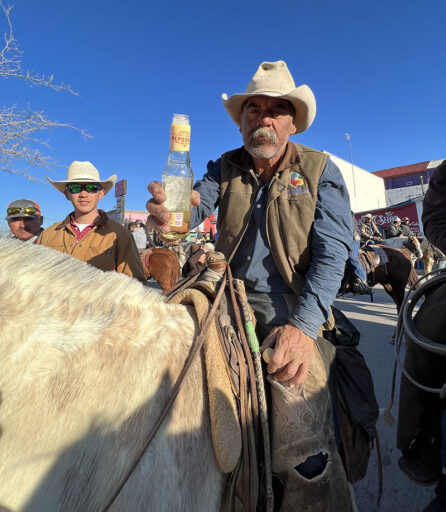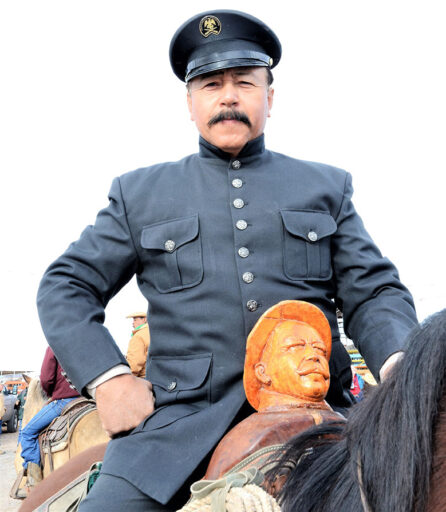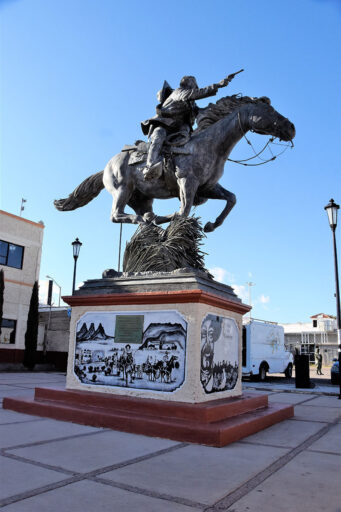
WITH FLAGS OF BOTH COUNTRIES | Riders participating in the Villista Binational Cavalcade. (Photos/ Morgan Smith)
2022 CABALGATA BINACIONAL VILLISTA
Morgan Smith
Morgan-smith@comcast.net
Haga click aquí para leer la versión en español
It’s Friday, March 11 and the main street of tiny Palomas, Mexico ( pop. 4,700) is lined with cheering spectators as dozens of riders parade towards the central square with its huge statue of General Pancho Villa (1878-1923).
This is the 22d annual Cabalgata Binaciónal Villista or Binational Villa Cavalcade, an event designed to signify unity between our two countries as opposed to the conflict that occurred on March 9, 2016 when General Pancho Villa sent some 100 of his troops to raid Columbus, New Mexico, ( pop. 1,200) attacking members of the Third US Cavalry Regiment, burning part of Columbus and making off with about 100 horses and mules plus other supplies. Although eighteen Americans were killed, Villa lost about eighty of his troops.
From friend to enemy
Villa had been a friend of the US and had met with General John F. “Black Jack” Pershing at Fort Bliss several years earlier but when President Woodrow Wilson threw his support to Villa’s rival, Venustiano Carranza, Villa turned against the US.
Wilson then sent thousands of troops after Villa. Led by Pershing who later commanded the American Expeditionary Force in World War 1, they chased Villa unsuccessfully for eleven months. Pershing’s aide was then-First Lieutenant George S. Patton.

ON A MULE| A horseman carries tequila to endure the long journey.

TRIBUTE TO THE LEADER | Narciso dresses to remember Pancho Villa.
Villa’s presence is still powerful along the border
In Columbus across the border from Palomas, there is the Pancho Villa State Park and in the town square of Palomas the statue.
This particular event signifies unification rather than war. It began some twenty two years ago as a joint effort of Mexican and American riders. The Mexican riders come from a variety of towns south of Palomas; for many it is a lengthy trip. One rider on a white mule offered me a drink from his tequila bottle and said he had ridden seventeen days.
Mexican horsemen crossed on foot
On Saturday morning, we drove to the point in the border wall where the Mexican horses and riders normally enter the US from Mexico but no one was there. We were later told that there was a virus on the Mexican side and that those horses weren’t allowed to cross. However, many of the Mexican riders came across on foot and then rode horses lent to them by their American counterparts.
One of them was Narciso Martinez Alvarado, a Pancho Villa- look-alike who has participated many times and calls himself the International Ambassador of Villismo. While he was able to borrow a horse on the US side, he didn’t have with him his saddle with a wooden carving of Pancho Villa’s head as the saddle horn. He is a special leader with his humor and vitality.
As a result of the ban on horses from Mexico, the parade back from the border wall was entirely made up of American horses and riders plus those Mexican riders who walked across and then found horses to borrow. Nonetheless, the spirit was the same – one of unity. I give great credit to all of the riders, but especially the Mexican ones who have come from great distances.

IN PIGEONS| Statue of Pancho Villa in the central square of the town.
Rewarding Message
At a time when the tensions between our two countries are high, especially in regard to immigration issues, it’s gratifying to see basic ranchers and riders from Mexico make this huge effort to bring a sense of unity to our two countries. While our political leaders flounder and pontificate, it’s these men, women and children riders who have taken action to support the basic friendship between our two countries.
You may also like:
Secretary Pete Buttigieg: “President Biden has led an extraordinary recovery”





otras noticias
Guest Columnist – Latina Entrepreneurs Are Driving America’s Growth
Hello Catira! Venezuelan flavor with soul
Colorado Rush invites kids to play, grow, and dream